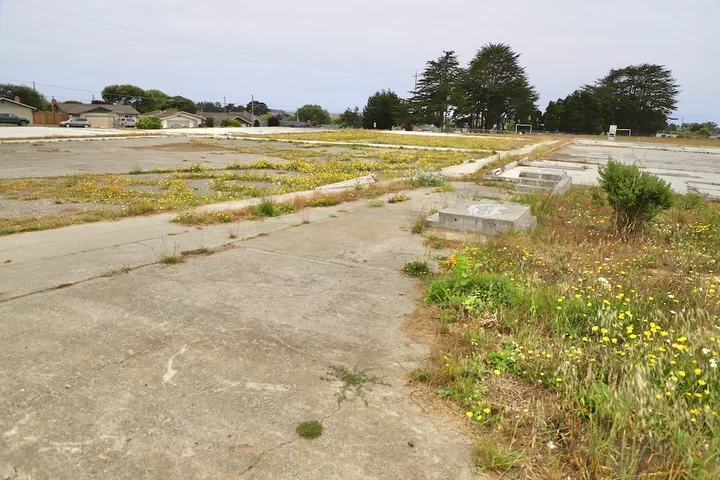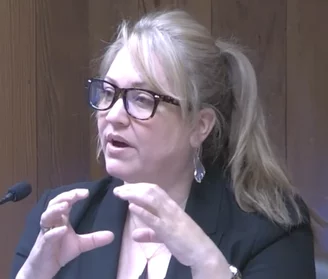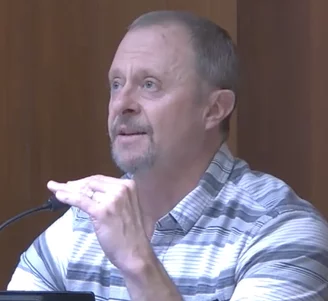The vacant Jacobs Campus in Eureka. File photo: Andrew Goff.
PREVIOUSLY: Eureka City Council Mulls Options for Jacobs Site
###
The City of Eureka is moving forward with a proposal that could influence future development at the former Jacobs Middle School Campus.
During last night’s regular meeting, the Eureka City Council voted 4-1, with Councilmember Renee Contreras-DeLoach dissenting, to direct staff to develop a “Mixed Neighborhood” overlay zone that would “add special requirements, limitations, or enhanced flexibility” on top of the base zoning designation of the Jacobs Campus. The overlay zone would provide design standards to ensure future residential or commercial development of the site fits in with the Highland Park neighborhood’s overall scale and character.
In simpler terms: The overlay zone, if approved, would prevent a developer from building something at the site that doesn’t match the rest of the neighborhood, like a high-rise apartment complex or a huge department store.
The push to control development at the long-disused school site comes about three months after the Eureka City Unified School District board of trustees unanimously voted to exchange the site to a mysterious private developer, known only as “AMG Communities-Jacobs, LLC,” for another small property and $5.35 million. The controversial land exchange, which has yet to be finalized, came about several months after the Citizens for a Better Eureka launched its “Housing for All and Downtown Vitality Initiative,” which would require the city to amend its General Plan to accommodate single- and multi-family housing on the Jacobs Campus.
The Jacobs Campus is currently zoned as “Public Facilities,” a designation that restricts land use to government facilities and schools. The Housing for All Initiative, if passed, would apply its own overlay zone that would authorize high- and low-density residential uses, public and quasi-public uses “compatible with a residential setting,” principally permitted commercial neighborhood-serving uses and uses allowed under the Downtown zoning designation.
During last night’s meeting, Development Services Director Cristin Kenyon noted that the initiative “doesn’t talk at all” about form and design standards for future development. “[The city’s] overlay would be focused on form, not use,” she said.
Contreras-DeLoach asked if the overlay would “prevent any of what the initiative is trying to do” and whether it would still allow for commercial uses.
“It would still allow the same uses,” Kenyon said. “[We’re] talking about what the buildings will look like, and the building could be occupied by any of those uses. … [There are], like, 100 uses that could be allowed under the initiative.”
The overlay zone could be applied to other Eureka neighborhoods. Kenyon emphasized that the proposal before council would be the first step in the development of the overlay zone. “We would develop an overlay and then we bring it to you to adopt into the code [but] it wouldn’t yet apply anywhere,” she said. “And then, separately, you could take an action to apply it in the future as you thought fit.”
At the council’s last meeting on March 19, Councilmember Scott Bauer expressed concern that the overlay project would get in the way of other important projects. During that discussion, Kenyon admitted that staff “was swamped” but said hiring a consultant to help develop the overlay would offer some relief.
Councilmember Kati Moulton returned to the issue and asked if staff had any other concerns about the overlay development process and potentially putting it in front of other projects.
“I don’t think staff could tell you specifically what this would delay or anything like that, but obviously putting this on there would be an additional workload for staff,” said City Manager Miles Slattery. “Things pop up all the time … . Emergencies happen and priorities get changed, but it’s up to council to determine what direction that staff [chooses].”
Bauer spoke in favor of the overlay but said he was “still torn” about taking staff away from other important projects. “I think this is a good idea, I really do,” he said. “But we have a lot of stuff on our plate and we’re adding another thing that might delay other things. I struggle with that, you know? I really want us to explore this but is this the [right] time?”
Councilmember Leslie Castellano said the overlay would serve as one more tool in the city’s toolbox.
“I think of an overlay as a tool [that] we don’t have thus far,” she said. “We use hammers all the time in our zoning code, but maybe we don’t have a really cool router for a special custom carpentry. … Sometimes we don’t need that router but every now and again, we’re gonna make a really cool cabinet with [it] that … has some cool regenerative community building component that we would have never had before. … That’s why I support it.”
During the public comment portion of the meeting, Eureka resident Thomas Stewart said “rezoning [the] Jacobs [Campus] without information from the developer [would be] improper.” Like many others, he speculated that Security National President and CEO Rob Arkley was behind the land exchange, although company founder Rob Arkley has denied any involvement. Stewart was so sure of himself that he put up a bet. [CORRECTION: Stewart did not specifically mention Arkley.]
“I will wager here tonight 10 Bitcoin,” he said, placing something on the podium. “If I’m wrong, you can keep them. If I’m right, please give them back to me. Any questions?”
Confused by the gesture, Eureka Mayor Kim Bergel called for a “point of order” and said the council could not accept his bet. “We appreciate that, but we can’t accept it,” she said.
After a bit of confusion and Stewart claiming he would be “a dead man” if he took the Bitcoin back, he admitted that they were fake and he had bought them on eBay for 10 bucks.
Michael Munson, one of the proponents of the Housing for All Initiative, asserted that the proposed overlay zone would conflict with the upcoming ballot initiative and urged the council to wait for the November General Election before taking any action on the matter.
“According to Election Code 9217, if the initiative were adopted, it would prohibit the city from adopting a General Plan or zoning [amendment] that would be in conflict with the initiative,” Munson said. “Also, the proposed overlay zone is purported to be exempt from CEQA [California Environmental Quality Act]. That’s not true either. … I think this is just a huge waste of money at this point.”
A section of the aforementioned section Election Code states, in part, “No ordinance that is either proposed by initiative petition and adopted by the vote of the legislative body of the city without submission to the voters, or adopted by the voters, shall be repealed or amended except by a vote of the people, unless provision is otherwise made in the original ordinance.”
City Attorney Autumn Luna did not address Munson’s claims directly but, at one point during the meeting, reiterated that staff was “simply asking council to authorize some money and some additional staff time” to look into the development of an overlay zone. “We are not changing the zoning code tonight.”
Luna did not respond to the Outpost’s immediate request for additional comment. We’ll update here if we hear back.
After a bit of additional discussion on the matter, Moulton made a motion to direct staff to hire a contractor for up to $40,000 to develop a “Mixed Neighborhood” overlay zone for the Jacobs Campus. The motion was seconded by Fernandez.
Before voting on the item, Contreras-DeLoach warned the council that she would be voting against the item because she wasn’t comfortable with the precedent that the overlay zone would set.
The motion was approved 4-1, with Contreras-DeLoach dissenting.
###
Other notable bits from the meeting:
- The city council unanimously approved a Memorandum of Understanding (MOU) between the city, Ink People Center for the Arts, Eureka Main Street and Wiyot Tribe for the recertification of the Eureka Cultural Arts District (ECAD). The ECAD is one of 14 cultural arts districts in California. The city was recently awarded $671,429 from the state to further local artistic endeavors. The funds will be disbursed over a five-year certification period.
- The city council also received an update on Eureka’s Capital Improvement Program. The council received an extremely thorough report from City Engineer Jesse Willor, who went over dozens of projects that have been completed in the last year, and dozens more that are in progress, including various road improvement projects.



CLICK TO MANAGE